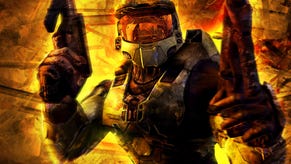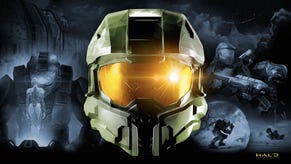PC's new Halo Combat Evolved tested: the Master Chief Collection expands - but how good is the port?
Gameplay is golden, performance is great - but it's far from the definitive edition.
Another piece of the puzzle slots into place as PC owners receive a new title for Halo: The Master Chief Collection. The original Halo Combat Evolved - or more specifically, its Anniversary Edition - is now available. Overall, it's a good port of the existing Xbox One edition of the game, bringing with it a range of options never seen before on the existing PC version. However, by extension, as an Xbox One port, this also means that a host of smaller but heavily criticised issues inherent to console version make their way across to PC too when we really would have loved to have seen these problems properly addressed once and for all.
In this freshly minted port of Halo: Combat Evolved Anniversary Edition, PC owners get access to a number of features from the original remastering effort, layered on top of a conversion of the original experience. Important is the inclusion of the remastered graphical presentation from Saber Interactive, filled with screen-space ambient occlusion and shadows, character models from Halo Reach and new textures. I'll lay my cards on the table here - I'm not a big fan of the changes to the art and the shift to the overall mood brought about by this remaster, but it's just as optional as it was in the original release. Users can toggle the presentation between OG and remastered visuals in real-time simply by pushing the tab button on the keyboard. Alternatively, players can choose which version to play from the get-go via the options screen.
However, new to this version is the option to change to the 'original' soundscape in the game, the audio that shipped with Halo from the original Xbox game, as well as the standard Anniversary Edition mix. This leads us on to the first problem I can see with this port. Yes, you get the source Xbox audio, but what you don't get is the far superior EAX audio mode that shipped with Gearbox's Halo conversion way back in 2003. Watch the video below and you'll see - or rather hear - that a fundamentally superior audio mix is available but not included. Also strange is that the original soundscape mode on PC seems to randomly insert shield or plasma pistol charge sounds at random. Hopefully both of these issues can be corrected.
In terms of play, PC users finally get the ability to experience Halo in campaign co-op, something that was unfortunately omitted from the 2003 release. It works flawlessly and I love it. Unlike my experiences in Halo Reach, my coop partner and myself did not have to put up with any hang-ups or stuttering - and most importantly there was none of the perceptible input lag I experienced in the Halo Reach conversion.
It works wonderfully and shows off just how amazing Halo is all these years later. I particularly love the details, like how the hammer slides back and forth when shooting the pistol, or how you can watch the assault rifle's ammo counter deplete during combat if you watch your coop partner closely. My only regret? Split-screen coop - a key aspect of the Halo DNA - is not in this release, just as it was omitted in Reach's PC port. Sure, the PC isn't exactly renowned for local coop play, but Halo definitely is - and this is the platform that can pull it off beautifully without having to worry about CPU or GPU resource issues.
Much like Halo Reach, Halo CEA on PC has access to enhanced graphics settings. You can match visuals to the Xbox One port or you can push further with a PC exclusive enhanced mode. Alternatively, you can pull back visuals for enhanced performance. Obviously, it's the enhanced mode we recommend. This increases texture detail on many objects, boosts shadow map resolution and perhaps more importantly of all, enhances draw distance - all with a fairly minimal hit to performance on a modern games PC. This is the best way to play, but there is an unfortunate bug: there's a problem in how SSAO scales, leaving vertical banding in all of the game's shadowed regions. I hope this is another aspect that can be fixed in due course to make the enhanced mode one step closer to perfection.
The performance mode effectively reverses these enhancements and then some. Shadows get massively pared back to a lower resolution, decals are removed, and the LOD distance for grass is brought right up close to the player camera. Here I saw around an 18 per cent performance increase in GPU-limited areas, and a more minor nine point boost in CPU-limited scenarios. The increases may be more profound on low-end kit but the fact is that both GTX 1060 and RX 580-level PCs can easily pull off 4K gameplay at 60fps or over, even with enhancements active. Interestingly, the 1060 suffers badly comparatively at 1440p or lower.
Regardless, high frame-rate gaming is on the table, even with the remastered graphics at their highest - and it can be pulled off on mid-range GPU hardware. Also, unlike Halo Reach, FPS interpolation and higher than 60fps frame-rates work properly this time around, but that does not mean that it is completely perfect. Plasma weapon effects such as the shots from stationary plasma turrets, plasma pistols and plasma rifles all update at 30fps no matter your chosen frame-rate target.
This also applies to the update rate for the energy swords carried by Elites which can look really awkward as the arms move out of sync with the sword they are supposed to be carrying. Most surprising for me was that all of the cinematics in the game have animation rates tied to 30fps, while the camera in these cinematics moves at an uncapped frame-rate. So basically, the new port of Halo exhibits many of the same problems that Halo PC had all the way back in 2003. Perhaps this is done for reasons of syncing cutscene playback in coop play.
These frame-rate problems for certain animations are somewhat surprising to me because the Chimera mod for the original 2003 PC release unlocks the frame-rate of animations and interpolates them, creating workarounds for this issue - so I'm curious as to why a new 2020 port has these issues when existing mods have been available for some time that cure 17-year-old limitations with the original port. Surely with all the time, money and resources available to 343 Industries, the firm should be able to match the efforts of the Halo community?
With that in mind, we come to the most problematic issue with this new release. While it plays extremely well and offers new visuals and cooperative experiences we've never seen before on PC, the visual foundations for this release are still not right - something that's very important in preserving a genuine classic. The original Gearbox version of Halo from 2003 was released missing visual aspects found in the original Xbox version and the MCC version of Halo CEA on Xbox One and in this PC version inherit those problems. The issues are found right across the game and can really have a negative effect on the intended visuals. Transparencies and fog effects are often incorrectly delivered, textures and bump mapping effects can present poorly - and that's really just the tip of the iceberg. Take a look at the video above for more examples, but even that is just a fraction of the overall level of inaccuracy in the conversion.
The thing is that these are issues that have been known about for a long time in the Halo community, problems that the community has actively sought to resolve via modding. Today you can download the Halo Restoration and have a version of the game on PC which does not have many of the visual problems that the Master Chief Collection has. And it's here where I really hope that the team behind this new Halo CEA port can perhaps draw some inspiration from the community and work to address these issues once and for all. It's all about preservation: Halo as a game deserves to look as art-correct as possible with Bungie's original design, as it is a timelessly gorgeous game. Its extensive use of effects, bump mapping, and other DirectX 8 trickery made it such a stand-out title back in the day and really, the official 343 port should hold up and continue this proud legacy.
Ultimately, it's important to look at this port in a balanced fashion, as clearly it has its good points and its bad points. There's no doubt that we are looking at the most playable version of Halo available with excellent performance and a laudable implementation of cooperative play - something that the PC version has never had and something that is core to Halo's DNA. As an experience, it's still brilliant, it's still undeniably Halo and I love it but as an exercise in preserving one of the greatest games of all time for the generations to come, I hope to see further efforts poured into this conversion. For a game this important, it needs to be everything it can be.










